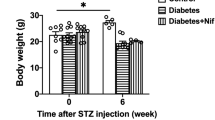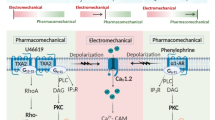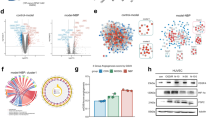Abstract
Endothelial cells (ECs) are the critical cellular element responsible for postnatal angiogenesis. Since the calcium channel blocker (CCB) nifedipine indirectly upregulates endothelial superoxide dismutase expression by stimulating the production of vascular endothelial growth factor (VEGF) from smooth muscle cells (SMCs), we examined whether nifedipine would induce human coronary artery endothelial cell (HCEC) tube formation via an increase in VEGF production from human coronary artery SMCs (HCSMCs) in an in vitro model. Nifedipine stimulated VEGF production from HCSMCs, and this stimulation was abolished by protein kinase C (PKC) inhibitors and a bradykinin B2 receptor antagonist. In addition, supernatant derived from nifedipine-treated HCSMCs induced HCEC tube formation. This tube formation was inhibited by pretreatment with a specific inhibitor of kinase insert domain-containing receptor/fetal liver kinase-1 (KDR/Flk-1) tyrosine kinase and an inhibitor of nitric oxide (NO) synthase. In conclusion, nifedipine increases VEGF secretion through PKC activation via the B2 receptor. The VEGF secretion directly induces HCEC tube formation via the KDR/Flk-1/NO pathway. CCBs may thus have novel beneficial effects in improving coronary microvascular blood flow in addition to their main effect of reducing blood pressure.
Similar content being viewed by others
Article PDF
References
Opie LH : Should calcium antagonists be used after myocardial infarction? Ischemia selectivity versus vascular selectivity. Cardiovasc Drugs Ther 1992; 6: 19–24.
Yui Y, Sumiyoshi T, Kodama K, et al: Nifedipine retard was as effective as angiotensin converting enzyme inhibitors in preventing cardiac events in high-risk hypertensive patients with diabetes and coronary artery disease: the Japan Multicenter Investigation for Cardiovascular Diseases-B (JMIC-B) subgroup analysis. Hypertens Res 2004; 27: 449–456.
Yui Y, Sumiyoshi T, Kodama K, et al: Comparison of nifedipine retard with angiotensin converting enzyme inhibitors in Japanese hypertensive patients with coronary artery disease: the Japan Multicenter Investigation for Cardiovascular Diseases-B (JMIC-B) randomized trial. Hypertens Res 2004; 27: 181–191.
Saida K, van Breemen C : Mechanism of Ca++ antagonist-induced vasodilation. Intracellular actions. Circ Res 1983; 52: 137–142.
Gross GJ, Farber NE, Pieper GM : Effects of amlodipine on myocardial ischemia-reperfusion injury in dogs. Am J Cardiol 1989; 64: 94I–100I.
Alexander JJ, Miguel R, Piotrowski JJ : The effect of nifedipine on lipid and monocyte infiltration of the subendothelial space. J Vasc Surg 1993; 17: 841–847.
On YK, Kim CH, Oh BH, Lee MM, Park YB : Effects of angiotensin converting enzyme inhibitor and calcium antagonist on endothelial function in patients with essential hypertension. Hypertens Res 2002; 25: 365–371.
Orth SR, Nobiling R, Bonisch S, Ritz E : Inhibitory effect of calcium channel blockers on human mesangial cell growth: evidence for actions independent of L-type Ca2+ channels. Kidney Int 1996; 49: 868–879.
Dimmeler S, Zeiher AM : Endothelial cell apoptosis in angiogenesis and vessel regression. Circ Res 2000; 87: 434–439.
Isner JM, Asahara T : Angiogenesis and vasculogenesis as therapeutic strategies for postnatal neovascularization. J Clin Invest 1999; 103: 1231–1236.
Fukuo K, Yang J, Yasuda O, et al: Nifedipine indirectly upregulates superoxide dismutase expression in endothelial cells via vascular smooth muscle cell-dependent pathways. Circulation 2002; 106: 356–361.
Fukuo K, Yang J, Suzuki T, et al: Nifedipine upregulates manganese superoxide dismutase expression in vascular smooth muscle cells via endothelial cell-dependent pathways. Hypertens Res 2003; 26: 503–508.
Fujimura Y, Tsuboi H, Esato K : Efficacy of benidipine hydrochloride on myocardial ischemia and reperfusion. J Surg Res 1995; 59: 321–325.
Miura S, Matsuo Y, Saku K : Transactivation of KDR/Flk-1 by the B2 receptor induces tube formation in human coronary endothelial cells. Hypertension 2003; 41: 1118–1123.
Miura S, Fujino M, Matsuo Y, et al: High density lipoprotein-induced angiogenesis requires the activation of Ras/MAP kinase in human coronary artery endothelial cells. Arterioscler Thromb Vasc Biol 2003; 23: 802–808.
Miura S, Emoto M, Matsuo Y, Kawarabayashi T, Saku K : Carcinosarcoma-induced endothelial cells tube formation through KDR/Flk-1 is blocked by TNP-470. Cancer Lett 2004; 203: 45–50.
Miura S, Karnik SS : Ligand-independent signals from the angiotensin II type 2 receptor induce apoptosis. EMBO J 2000; 19: 4026–4035.
Verhaar MC, Honing ML, van Dam T, et al: Nifedipine improves endothelial function in hypercholesterolemia, independently of an effect on blood pressure or plasma lipids. Cardiovasc Res 1999; 42: 752–760.
Watanabe S, Ono H, Ishimitsu T, et al: Calcium antagonist inhibits glomerular cell apoptosis and injures of L-NAME exacerbated nephrosclerosis in SHR. Hypertens Res 2000; 23: 683–691.
Knox AJ, Corbett L, Stocks J, et al: Human airway smooth muscle cells secrete vascular endothelial growth factor: up-regulation by bradykinin via a protein kinase C and prostanoid-dependent mechanism. FASEB J 2001; 15: 2480–2488.
Gruden G, Thomas S, Burt D, et al: Mechanical stretch induces vascular permeability factor in human mesangial cells: mechanisms of signal transduction. Proc Natl Acad Sci U S A 1997; 94: 12112–12116.
Berse B, Hunt JA, Diegel RJ, et al: Hypoxia augments cytokine (transforming growth factor-beta (TGF-beta) and IL-1)−induced vascular endothelial growth factor secretion by human synovial fibroblasts. Clin Exp Immunol 1999; 115: 176–182.
Shih SC, Mullen A, Abrams K, Mukhopadhyay D, Claffey KP : Role of protein kinase C isoforms in phorbol ester-induced vascular endothelial growth factor expression in human glioblastoma cells. J Biol Chem 1999; 274: 15407–15414.
Nishizuka Y : Intracellular signaling by hydrolysis of phospholipids and activation of protein kinase C. Science 1992; 258: 607–614 ( Review).
Block LH, Emmons LR, Vogt E, Sachinidis A, Vetter W, Hoppe J : Ca2+-channel blockers inhibit the action of recombinant platelet-derived growth factor in vascular smooth muscle cells. Proc Natl Acad Sci U S A 1989; 86: 2388–2392.
Block LH, Matthys H, Emmons LR, Perruchoud A, Erne P, Roth M : Ca2+-channel blockers modulate expression of 3-hydroxy-3-methylglutaryl-coenzyme A reductase and low density lipoprotein receptor genes stimulated by platelet-derived growth factor. Proc Natl Acad Sci U S A 1991; 88: 9041–9045.
Hempel A, Lindschau C, Maasch C, et al: Calcium antagonists ameliorate ischemia-induced endothelial cell permeability by inhibiting protein kinase C. Circulation 1999; 99: 2523–2529.
Zernig G : Clinical future for Ca2+ antagonists looks more promising. Trends Pharmacol Sci 1991; 12: 439–442.
Herbette LG, Vant Erve YM, Rhodes DG : Interaction of 1,4 dihydropyridine calcium channel antagonists with biological membranes: lipid bilayer partitioning could occur before drug binding to receptors. J Mol Cell Cardiol 1989; 21: 187–201.
Author information
Authors and Affiliations
Corresponding author
Rights and permissions
About this article
Cite this article
Miura, Si., Fujino, M., Matsuo, Y. et al. Nifedipine-Induced Vascular Endothelial Growth Factor Secretion from Coronary Smooth Muscle Cells Promotes Endothelial Tube Formation via the Kinase Insert Domain-Containing Receptor/Fetal Liver Kinase-1/NO Pathway. Hypertens Res 28, 147–153 (2005). https://doi.org/10.1291/hypres.28.147
Received:
Accepted:
Issue date:
DOI: https://doi.org/10.1291/hypres.28.147
Keywords
This article is cited by
-
Mmu_circ_0000271 regulated the growth of ox-LDL-stimulated mouse vascular smooth muscle cells via sponging miR-5123
Genes & Genomics (2022)
-
Etiology and management of hypertension in patients with cancer
Cardio-Oncology (2021)
-
Österreichischer Blutdruckkonsens 2019
Wiener klinische Wochenschrift (2019)
-
Tyrosine Kinase Inhibitor-Induced Hypertension
Current Oncology Reports (2018)
-
Management of VEGF-Targeted Therapy-Induced Hypertension
Current Hypertension Reports (2018)



